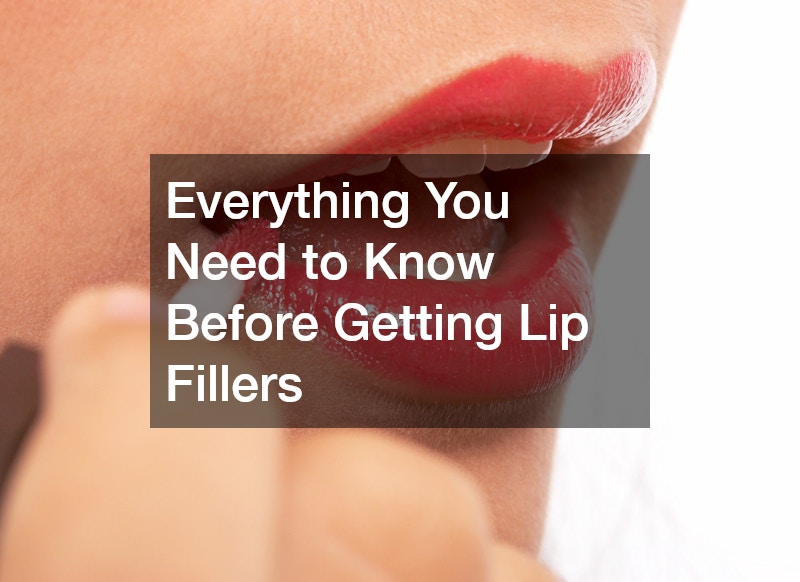
This article aims to provide a comprehensive guide for anyone considering lip fillers. With growing popularity, there are many considerations and questions people have before undergoing this cosmetic procedure. We will delve into the most critical aspects to ensure you are fully informed before making your decision.
What Are Lip Fillers Made Of?
Types of Lip Fillers
Lip fillers primarily consist of a variety of substances that add volume to the lips. The most popular types are Hyaluronic Acid-based fillers, which are celebrated for their ability to retain moisture and add a natural plumpness.
Collagen was one of the original materials used in lip enhancement; however, its use has declined due to advances in Hyaluronic Acid treatments. There are other fillers with different compositions, but they are generally less favored for lip applications.
Choosing a filler depends on desired outcomes and personal preferences for ingredients. Many clinics offer consultations to determine which type might be best suited for individual needs.
Safety and Ingredients
The safety profile of lip fillers has significantly improved over the years, thanks largely to advances in the development of Hyaluronic Acid-based products. This naturally occurring substance in the body reduces the likelihood of adverse reactions and supports a safer procedure overall.
Common ingredients in these fillers not only prioritize their effectiveness but also their compatibility with body tissues. In some cases, numbing agents may be included within the filler to improve patient comfort during the procedure.
Potential risks associated with lip fillers can be minimized by choosing a certified and experienced practitioner. Understanding the ingredients used and their purposes is essential in making an informed decision.
What to Expect During and After the Procedure?
Procedure Overview
The lip filler procedure typically starts with a consultation to assess the client’s goals and health status. Once consent is given, the practitioner will carefully map out the injection sites to ensure symmetry and desired fill levels.
During the procedure, a thin needle is used to inject the filler into specific areas of the lips, usually completing the process within 30 minutes to one hour. Patients may experience some discomfort, but most practitioners use a topical numbing agent to mitigate pain.
Immediately after the injections, practitioners often massage the lips to evenly distribute the filler and prevent lumps. The patient is then advised to follow specific aftercare instructions to assist recovery and achieve optimal results.
Recovery and Aftercare Tips
Post-procedure care is crucial for minimizing swelling and ensuring the best outcomes. Patients are generally advised to avoid applying pressure to the area and to refrain from vigorous exercise for at least 24 to 48 hours.
Slight swelling and bruising are common in the initial days following the procedure. However, these effects are typically mild and reduce significantly within a week, revealing the improved lip contour and volume.
Patients are encouraged to follow up with their practitioner if they have any concerns or unusual symptoms. Adhering strictly to the aftercare regimen can significantly contribute to a smooth recovery and satisfying results.
How Much Do Lip Fillers Cost?
Factors Affecting Cost
The cost of lip fillers can vary widely depending on several factors, including geographic location and the expertise of the practitioner. Urban centers typically exhibit higher prices due to increased demand and operating costs.
Brand and type of filler also influence the pricing; premium brands with longer-lasting effects are generally more expensive. An experienced injector may charge more for their services due to the assurance of quality and safety.
Potential clients should consider these variables when budgeting for the procedure. Thoroughly researching clinics and practitioners can result in better value and a more satisfying experience overall.
Budgeting and Cost Considerations
To effectively budget for lip fillers, it is crucial to look beyond the initial treatment cost. Follow-up appointments and potential touch-ups should be factored into the total expenditure.
Some clinics offer package deals or loyalty discounts for repeat clients, which can make ongoing treatments more affordable. It is also wise to include an allowance for possible side treatments, such as lip balms or creams that promote healing.
Understanding the long-term financial implications of lip fillers helps make the decision more manageable. Developing a comprehensive budget can help ensure that maintaining desired results aligns with one’s financial capabilities.
Deciding on lip fillers is a personal choice that involves many considerations. By understanding what the procedure entails, what ingredients are used, what to expect post-procedure, and the costs involved, you can make an informed decision that aligns with your beauty goals and budget. Consulting with a qualified professional is also key to ensuring safety and satisfaction. Take the time to ask questions, review before-and-after results, and consider your long-term maintenance plan. Whether you’re looking for a subtle enhancement or a bold transformation, being well-informed will help you feel more confident and comfortable with your decision.




